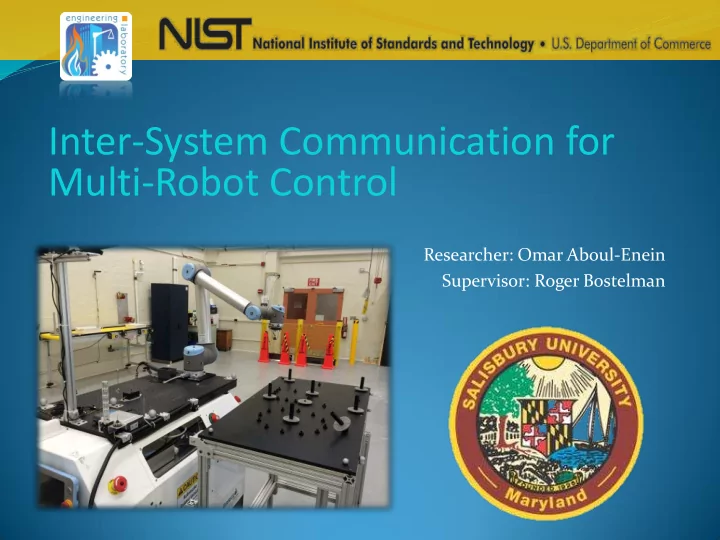

Inter-System Communication for Multi-Robot Control Researcher: Omar Aboul-Enein Supervisor: Roger Bostelman
NIST SURF Program National Institute of Standards and Technology A non-regulatory federal agency within the Department of Commerce Founded in 1901 Summer Undergraduate Research Fellowship Engineering Laboratory Intelligent Systems Division
Context Laboratory Goal: Develop simple, accurate, and cost effective test methods for Mobile Manipulators AGVs and robots arms from different manufacturers currently lack mechanisms for collaboration. Performance tests consist of multiple cases regarding AGV and robot arm coordination. [1] Mobile Manipulators currently lack standardized test methods. Development of test methods would typically use costly and complex ground truth systems. Project Goal: Develop AGV and robot arm communications to allow NIST to develop standardized test methods for Mobile Manipulators. [1]Bostelman, R., Hong, T., Marvel, J. (n.d.). Performance measurement of mobile manipulators .
Universal Robot Arm (UR10) Retroreflective Laser Emitter & Sensor Automated Guided Vehicle (AGV) Reflector Target Reconfigurable Mobile Manipulator Artifact (RMMA)
Project Tasks Industrial PC and ARToolkit Camera Sensor Integration 1. Integration and Calibration of ARToolkit Camera System 2. Development of “Mobile Manipulator Communications Manager” Software 3. Implementation of Static Cases 4. Development of Orientation Conversion for Dynamic Case
Successes Computer Science Education at Salisbury University enabled: Rapid understanding and utilization of algorithms and data structures. Excellence in code conventions and documentation Ability to interpret pre-written software packages Ability to analyze learning resources for quick comprehension of new topics.
Received Data Queue Transformed Data Queue Transmission Data Queue Queues Shared Between Threads • Raw ARToolkit • Raw ARToolkit Data • Raw ARToolkit Data Data • Discrete Data (A & B) • Discrete Data (A & B) • Robot Control Feedback • Dynamic Data (C) • Dynamic Data (C) Client Thread Server Threads Transformation Functions
Video: Static Case (A)
Challenges Dynamic nature of research Required ability to shift focus Analyze the practicality of pursuing certain challenges. Learning about Quaternions and 3D rotations New abstract concept Required extensive self-study and assistance from mentors. Learning experimental procedure for calibration tests Design performance experiements to suit needed analysis.
Scenario C: Dynamic Case Quaternion Conversion Image courtesy of www.euclideanspace.com ARToolkit computes the marker orientation in the quaternion number system. Quaternion number system consists of Imaginary components i, j, k A real component w. Quaternion representations of angles avoid computational problems such as gimbal lock. The Robot arm controller uses Euler angles (roll, pitch, yaw) to understand the arm’s orientation.
Acknowledgements NIST SURF Committee Lab Mates Roger Bostelman Leila Ettehadieh Vivienne Shaw Dr. Roger Eastman Justin Goh Dr. Jeremy Marvel Robert Walsh Dr. Tsai Hong Thank You for Listening!
Sources Cited [1]Bostelman, R., Hong, T., Marvel, J., & Foufou, S. (n.d.). Performance measurement of mobile manipulators . [2] About ROS. (n.d.). Retrieved from ROS website: http://www.ros.org/about-ros/ [3] ARToolkit. (n.d.). Retrieved from http://www.hitl.washington.edu/artoolkit/ [4] Baker, M. (n.d.). Maths - Quaternions. Retrieved from Euclidean Space website: http://www.euclideanspace.com/maths/algebra/realNormedAlgebra
Recommend
More recommend